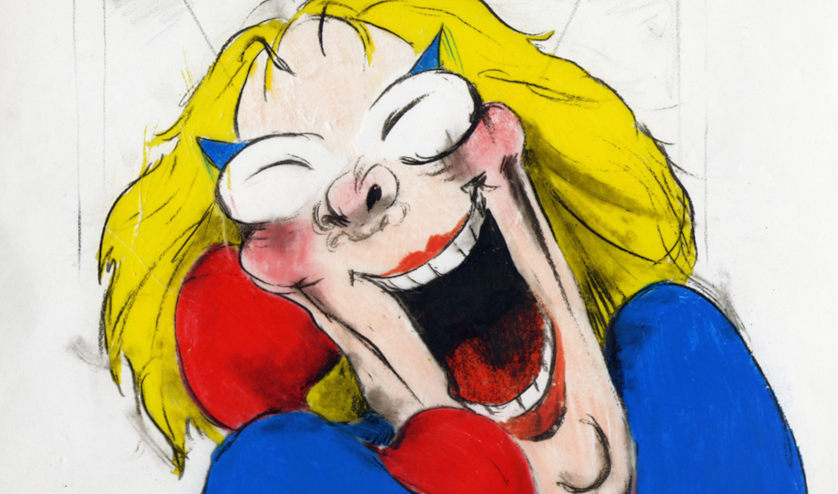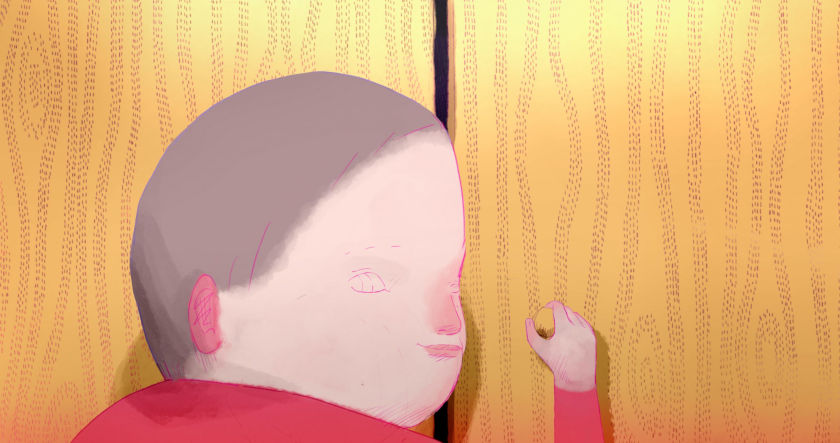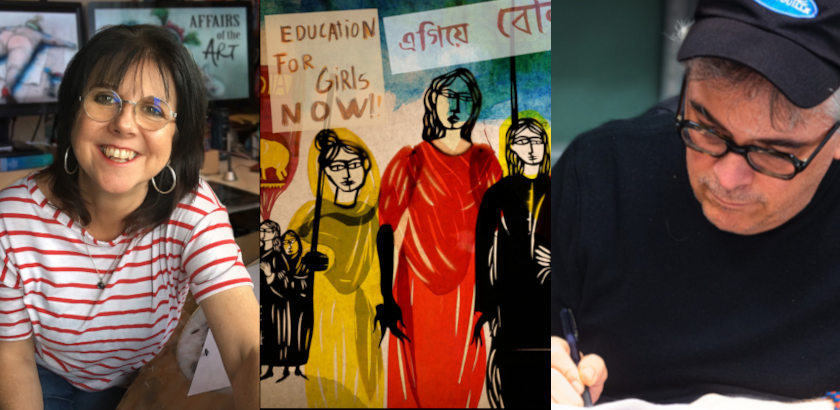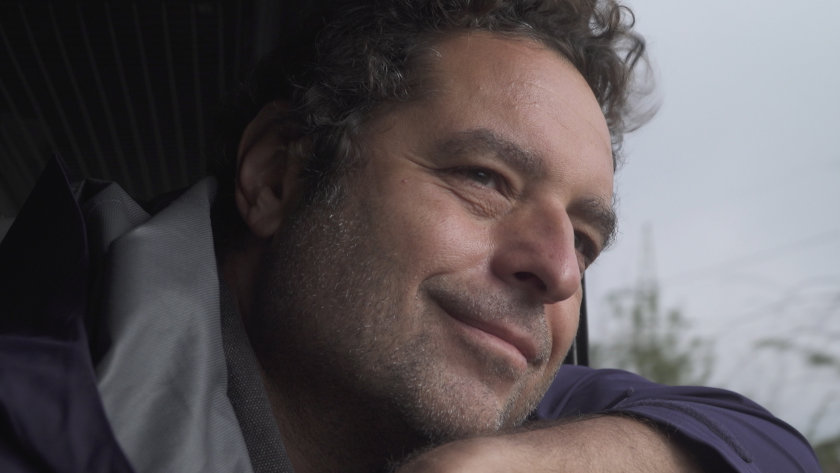Joanna Quinn and Les Mills Interview on Affairs of the Art: Beryl Is Still The Complex Anti-Heroine
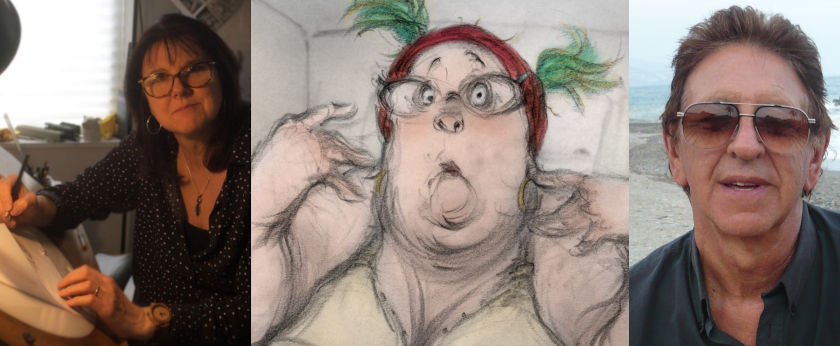
World premiering at Clermont-Ferrand International Film Festival this February, the new animation short film by Joanna Quinn and Les Mills, Affairs of the Art investigates more aspects of the Beryl character the duo so successfully created since Girls Night Out (1986).
A co-production between Beryl Productions International and The National Film Board of Canada, the 16-minute animation short presents Beryl, "the working-class heroine who not only reveals her own obsession with drawing but exposes the addictions of her eccentric family, which include pickling, screw threads and pet taxidermy".
We talked with both Joanna Quinn and Les Mills about Affairs of the Art and their own artistic trajectory.
ZF: Affairs of the Art is a film that everyone's waiting for. But it did take a long time to get off the ground. I was watching a 2010 interview about the film concept -and the idea and the script were surprisingly similar to the finished film.
JQ -LM: It's a long time, yes. But we haven't been working on the film for ten years, other things in normal life got in the way. Up until 2013, we were making lots of TV commercials mostly for the US, and we ran a full studio usually with almost 20 people working for us in our studio. It’s constant pressure doing deadlined ads. We only got down to concentrating on the film seriously after about 2015. We used our studio staff to work on the ads as well as our film. For this film we used a hard core crew of 4-5 people who worked on the film intermittently over the last 5 years.
LM: You can write a script relatively quickly but making an animated film out of is as you know, is much more difficult and time consuming especially the kind of animation that Joanna does, which is very specialist and labour- intensive, it’s altogether a different story!
JQ: I animated using TV Paint for 6 months. What I wanted to do was create animation that looked totally hand-drawn, and kept the organic feel of drawn animation on paper as I’ve done in my previous films, but, even though TVPaint is a fantastic and very intuitive piece of software, it is a very different thought process from when you're physically animating directly onto paper. I managed to animate the movement fine but I didn't enjoy the process because there were no surprises; you can see your animation as you are going along. There’s not that final moment in animating on TV paint where you can step back, watch it all in one go and easily spot the bits that don't work. I was enjoying the technical side (I love computers) but I just found that my animation wasn't as fluid. Les said 'why don't you switch back to paper'? and I said, 'I can't! I want to be modern!' But then I thought, 'why don't I?' So, I got my lightbox back out and I was much happier!
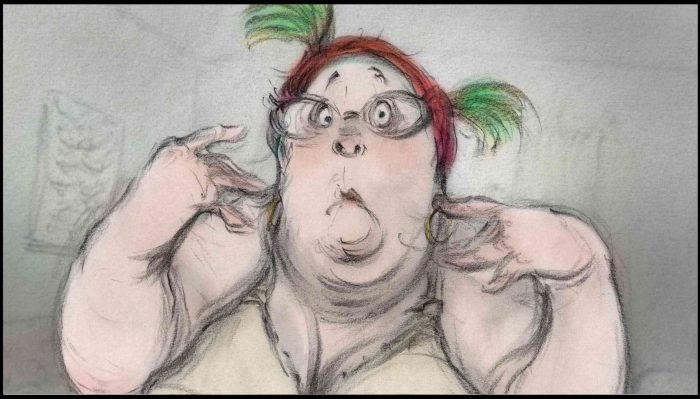
ZF: Still both of you are more modern than you'd otherwise assume. Body Beautiful (1991), which talks about harassment, came a long time before the #metoo movement. Dreams and Desires: Family Ties (1996) brought out video diaries before smartphones and selfies became everyday life.
LM: Yes, practically other things happened, both of us were teaching film and animation at University. There was a time when video diaries became very fashionable; obviously this was before mobile phones happened and you could do anything with your phone, in those days you needed to have your own video camera. I made my own video Diaries and I taught a module, where students had to film and examine themselves as subjects instead of filming others, that's where the idea came from for Dreams and Desires: Family Ties. It was a very difficult film to do, but it was great for the Beryl character to be state-of-the-art! In our film Affairs of the Art, Beryl does dabble with social media, Skype with her sister Beverly for example.
ZF: Since it was a long production process, were you actually tempted to change the script of Affairs of the Art before its actual production?
LM: I could have, but then it becomes an everlasting project -you can't stop it. I'm still critical of the script, but for a script that's taken so long to produce, you don’t have the same kind of ruthlessness toward it when the process is not deadlined and you are using your own funds.
JQ: Especially with comedy, you can be very critical about it after a time because the jokes tend to age very quickly -even though no one else has heard them. We were constantly thinking: 'Wouldn't it be funnier if we changed this?' We couldn't constantly change the script to entertain ourselves because it would become an endless process. Hopefully people will find still find it funny!
ZF: The character that steals the show for me in Affairs of the Art is Beverly, Beryl's sister.
LM: Since the last film (Dreams and Desires: Family Ties) which was very restrictive and shot POV, we realized that no one knew very much about other people in Beryl's life. We wanted people to know where Beryl came from, who were her family. In Affairs of the Art, we actually deliberately deviate from Beryl as a character, and get involved with Beryl's sister Beverly and her son Colin in an intimate way. We initially wanted to make it as three separate films: three very short pieces about Beverly, Beryl and Colin. It sort of ends up like that anyway. There's a lot of Beverly's and Colin's actions in the film - even though it's Beryl narrating.
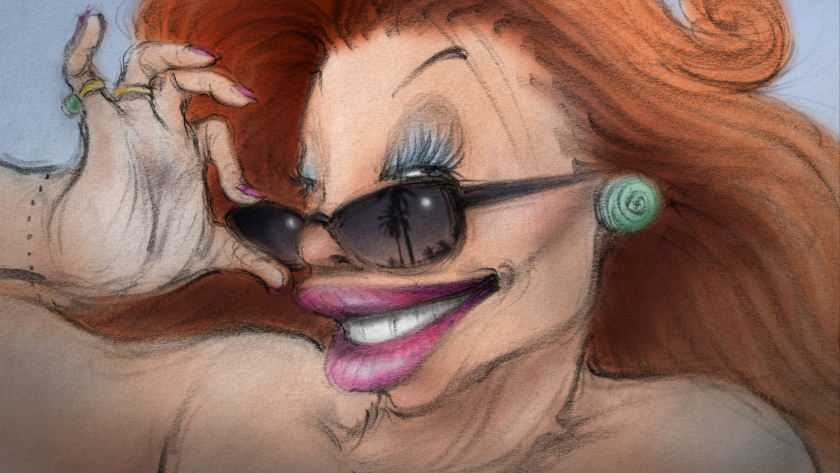
LM: Production-wise, these ideas go a long way back. We were financed by the Welsh television station S4C and Channel 4, with Clare Kitson serving as commissioning editor. She really knew and understood animation. She offered us a proposal to make 5 very short animation pieces, which were to be screened before the 8 o'clock news. That was fantastic! You never saw any kind of independent animation until 1 o'clock in the morning; only animation freaks would watch them at that time. So, I wrote 5 scripts and we got really excited about it; but then unfortunately she left Channel 4, and the next programmer dropped the ideas. We still made Dreams and Desires: Family Ties out of those ideas, with the support of Welsh television.
ZF: I liked the way Beryl, in your latest film, is generous enough to share the spotlight with the other characters. Especially the contrast between L.A.-based and successful Beverly and 'could have been a contender' Beryl makes a nice parable between US studio animation and independent animation.
LM: Actually, the idea of Beverly going to LA was once a film in its own right; it was called 'Beverly Thrills'. It was about her going to the US, becoming big and inviting Beryl there. Beverly is the opposite of Beryl: she's very ruthless from the start, whereas Beryl gradually becomes more determined.
JQ: We also did not want to be pigeonholed as doing 'another Beryl film'. We thought we explored her own character pretty well in our previous films; with this film, we deliberately made her the storyteller of her interesting family. And she's still the anti-heroine. It is also autobiographical in a way. Because we are doing ads for so many years, I am Beryl doing all these ads. This was terrific to do and a fantastic opportunity, but you are simply creating stuff based on other people's ideas - doing what other people want. So, we really really wanted to make a film to express what we wanted to say.
ZF: So, you are Beryl in real life, but at the same time you are voicing Beverly in the film.
JQ: Oh, yes!
LM: Joanna likes to perform (Joanna: I'm a terrible show off) She always said she wish she'd been an actress. She's very demonstrative and can do very different accents, switching from Irish to American. We did try American actresses for the Beverly role, but I said to Jo, 'I prefer your version; you do it'. Even though she doesn’t quite sound like a true American, we always have an escape clause: she's just a Welsh who went to live in L.A so she maintains a slight Welsh accent.
ZF: Where did you get the inspiration from Beryl's son, Colin?
LM: From my brother. We were born in Barry, South Wales, a port town. It was a busy sea port in those days, with a lot of European small freighters coming in, mostly Dutch. We only lived a few hundred metres from the docks. and he was an avid watcher of things: trains, boats etc. He got to know Dutch sailors, who gave him things (books, magazines). He bought a book 'Teach Yourself Dutch' and he changed his name from Brian to its Dutch version; he spoke perfect Dutch by the time he was ten. He bought Dutch things, and he had other interests as well. He wrote a book on screw threads. He's a world expert on the Great Western Railway, one of Britain's railway systems. All those things in the film are actually in a living person. Every time I see him, he starts talking about engines, trains etc. within 10 seconds (Joanna: He hasn't seen the film yet!).
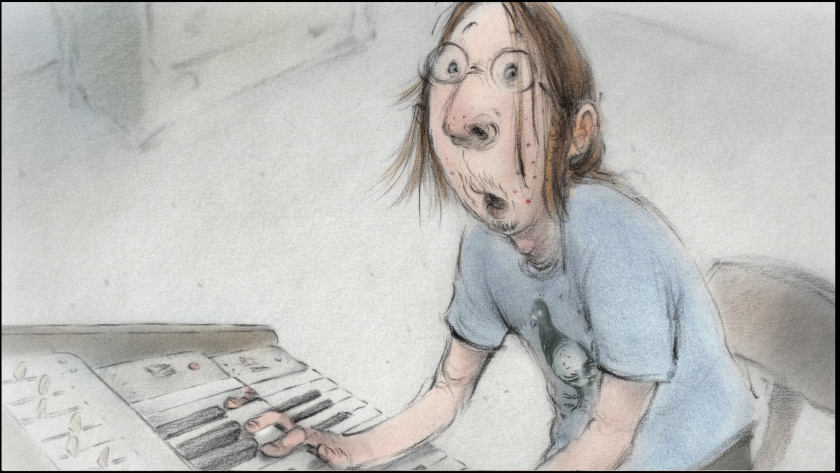
ZF: (Spoiler alert): I really liked the railway sequence, from the mouse that Beverly put on the train all the way to its funeral.
JQ: My own favourite one is the dead Granny sequence.
LM: It is certainly emblematic: having a mouse (a Disney symbol) in this sequence. And the funeral scene is one of my favorite ones. It is moving, even though it is designed to look quite comic and ridiculous but kids do things like that…
ZF: How would you go into realizing such a complex, multi-faceted story?
JQ: The storyboard was very thorough and big. Everything was absolutely sorted out at the start -we had enough time to do that. The way I work is to take the storyboard frame, I blow it up, and that becomes the layout. So much of the problem solving happens at this stage so I try not to change it; all the process and editing is done in the storyboard, which then becomes the animatic (so, we have the timing done).
But I'm not a big fan of backgrounds; I like things floating into space, so I'm at the happiest with no backgrounds whatsoever. My biggest challenge with Affairs of the Art is that most of it takes place inside the house. It was hard for me to confine everything and place it. Also, I wanted everything to boil three times; having done a single background, I had to do it twice more to make it wobble. On the other hand, if I had left the backgrounds loose and you didn't know where it was, it would only work for one scene on its own; when edited together with the other scenes, you would lose your sense of space. So, having established a background, a situation and a place, you then have to stick with it. That said, flying over Moscow and drawing Moscow was hard (she laughs).
LM: That's one of the reasons that I love Britannia (1993); there are no backgrounds, it's purely spatial and it works beautifully. But we always had backgrounds in Beryl films, and they have always been quite detailed. In the ads we did, we had a background artist. In our latest film, we kept arguing about whether we need a background artist or not, how many backgrounds to use ('it's an awful lot of white!'). It was driving me crazy. I would sometimes do some backgrounds: simple, quite precise and linear – but then we would get into a fight over that. Making a film with two people working very closely is very different from making a film with many people in differently assigned roles, where you give your instructions to the background artist and then they do this amazing work -and you check whether it fits the action or not.
JQ: Something that I was dreading but I ended up really enjoying was the lip sync. I was always trying to chop the dialogue down and just have animation, and Les was saying no. But then I did start to do the lip sync; I would film myself on my phone, getting the gestures and animated it all. And suddenly I realized that this is what I enjoyed doing more than anything; it's acting. It's the body language; the body moves first, and then the lips.
ZF: Your films are nothing but silent. Is it because of the Beryl character or because of the Joanna Quinn and Les Mills creators?
JQ: The nice thing about Beryl's character is that she's not very confident, and you get contrasts in her character. There are a lot of times when she's doubtful, and there are all sorts of lovely expressions you can do on her face, a lot of thoughts that you have to express through her face and eyes. So, she's not a simple character (evil, funny etc); she's quite complex. And it's quite a challenge to show her thought process in her face. That's what I enjoyed.
ZF: How did you come with the idea of Beryl in the first place in Girls Night Out (1986)?
JQ: Beryl was my first film when I graduated from Middlesex University It is an amalgamation of different characters who were around in my life at that time. My mum, a couple of other women I know, and her friends.
LM: And a woman who served at the college cafeteria where Joanna studied Those types of women are always warm, outgoing, maternal and chatty they are very reassuring for young trendy art students.
JQ: Yes our college was a very trendy and cool environment to be in, but quite intimidating and overwhelming; people were critical of the way you look etc. Just being nice was quite hard, I guess. But there was this lovely woman in the cafe, who looked just like Beryl - lots of students gravitated towards her. You just went there for a little bit of normality. She actually did voice Beryl at one point (before choosing Myfanwy Talog). It was then that I realized that that's why actors choose this for a job. Someone normal may be the type of person you want, but once you put a microphone in front of them, they go to pieces it's a completely different story.
My mum was an inspiration as well. My parents split up when I was young, and I stayed with my mum; even with a lot of financial problems, she had a fantastic sense of humour though and she never, ever complained. That's a quality that I put in Beryl: she's always struggling, but she never moans. She thinks a lot, and has a great sense of humour as well.
ZF: Did you ever think of Beryl in terms of labels: feminist, post-feminist etc?
LM: In the films we do, and right from the beginning, it's always women dealing with the ever present problem of maleness, and domination around them. In Girls Night Out, Beryl goes with her friends to a Male Stripper club; in those days, there were not many male strippers, but there were thousands of women strippers and men going to see them. So, our idea was, why can't women express themselves in that way?
JQ: During the late 80s, it was the era of Margaret Thatcher, the era of feminism, a very political time. The politics of feminism at that time were very strong, and I wanted to be part of it; but I do like humour as well. The feminist idea was to have a strong woman as the protagonist. So in doing “Girls Night Out” I was treating feminism in a humorous and accessible way; people would laugh with her, not at her.
LM: She was also a very working-class woman, not an intellectual. That was part of her character.
ZF: Beryl says in Affairs of the Art that she missed her opportunities of studying art. If we had a young woman in her place today, would it have been that difficult as well to study art?
LM: When we both went to college, we didn't pay any tuition fees, and we also had a yearly grant from the government to live on while studying. Any child, working class or otherwise could go to any college with the support of the state; and that was amazing. Nowadays, you're very lucky if you get any kind of support. No one had to borrow money from the state in those days. Students now have to get loans, which stay with them for half of their lives it’s very different and much more difficult for many students.
JQ: I didn't realize how expensive it was until our daughter went to college. It was £9,000 pounds tuition fees per year, and the living is so expensive, especially if you want to study in somewhere like London. And students who do pay and go to college to study are much more demanding. When I was at college, it was liberating, and no one was getting worried about getting a job - we were just experimenting and really enjoying the experience. The whole experience is very different now.
LM: Beryl tells in the film that she could have gone to college, but she got pregnant with Colin. At that time in the 60s she could have gone to college, even with a working-class background; she could have gone to college, because the state would have paid for her.
ZF: It is difficult to finance yourself to go to college, and it is also difficult to get financing for a short independent film. How Affairs of the Art was produced, being a co-production with the National Film Board of Canada?
LM: When we were making ads, we saved money in our 'Beryl fund'; to get funding if things got bad in terms of financing our own films. By that time, the TV broadcasters had stopped financing short independent animation. Most of the financing for the film comes from our own 'Beryl fund', with NFB financing the 25% of the film.
JQ -LM: Michael Fukushima got in touch with us, and asked us if we would like to do a co production. The plan was to do the post-production (sound, final dub etc.) at the NFB in Canada but in the end only the sound design (Olivier Calvert) was completed in Canada due to the restricting covid situation; the rest was done in the UK. It has been a real struggle with covid. We had a finishing date in mind, and suddenly we had to get out of our studio, and bring everything home to work and we did everything with Canada by Zoom meetings and emails.
ZF: Joanna, did you have to go back to your Beryl drawings when you were designing the characters for Affairs of the Art?
JQ: I did have to go back, in order to tie them together; so much time had passed. When you're doing commercials for so long, your artline gets tighter and tighter in your drawing style, so that everyone in the big team you're working with can follow things easily. So I did have to go back to remind myself how loose my work was before I did ads
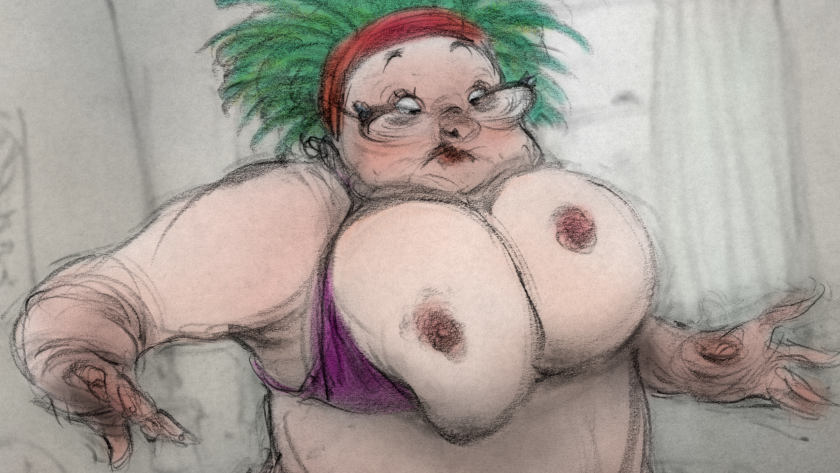
LM: People like two things in Jo's work. The first is characterization; the second is the quality of the animated line. It is liquid, dynamic and energetic. It was very difficult to keep that in this film, with all the time passing by, and so many things going on in between.
JQ: Animation is much easier for me when you start from A to go to B, and both A and B are completely different things; you go on a journey. When A and B are really similar, it is really boring and hard to be loose; there's no distance to travel, no big changes. So, I was always trying and change the key drawings in the film, so there is a little, mini-journey. On the other hand, it looks wrong if the drawings are all loose; it looks wobbly.
ZF: Would you agree with Beverly's statement in the film that 'my body is my art'?
LM: Beverly's art is a completely different thing; initially she transforms dead things into a business affair; she's obsessed with her own body, like Cindy Sherman and the Kardashians, both women who transform themselves into renditions of an idea, one of them, Sherman into Art pieces.
ZF: How do you feel about premiering at Clermont-Ferrand?
JQ-LM: It's great, we wish we could go there. It's a fantastic short film festival; we've never been before, and it would have been a great opportunity to see the film in front of an audience. The only thing is that after all this work, we can talk about it like we are doing now but basically no one can see it on the big screen. It's really a empty vacuum after all those 10 years. But we're really thrilled at the film being shown there as the world premiere; it's fantastic. Hopefully, one day we'll be able to experience a real living audience reaction as well.
Affairs of the Art is a co-Production between Beryl Productions International Ltd and The National Film Board of Canada. It will have its world premiere at the Clermont-Ferrand FIlm Festival (29 January - 6 February 2021). Watch the festival online




